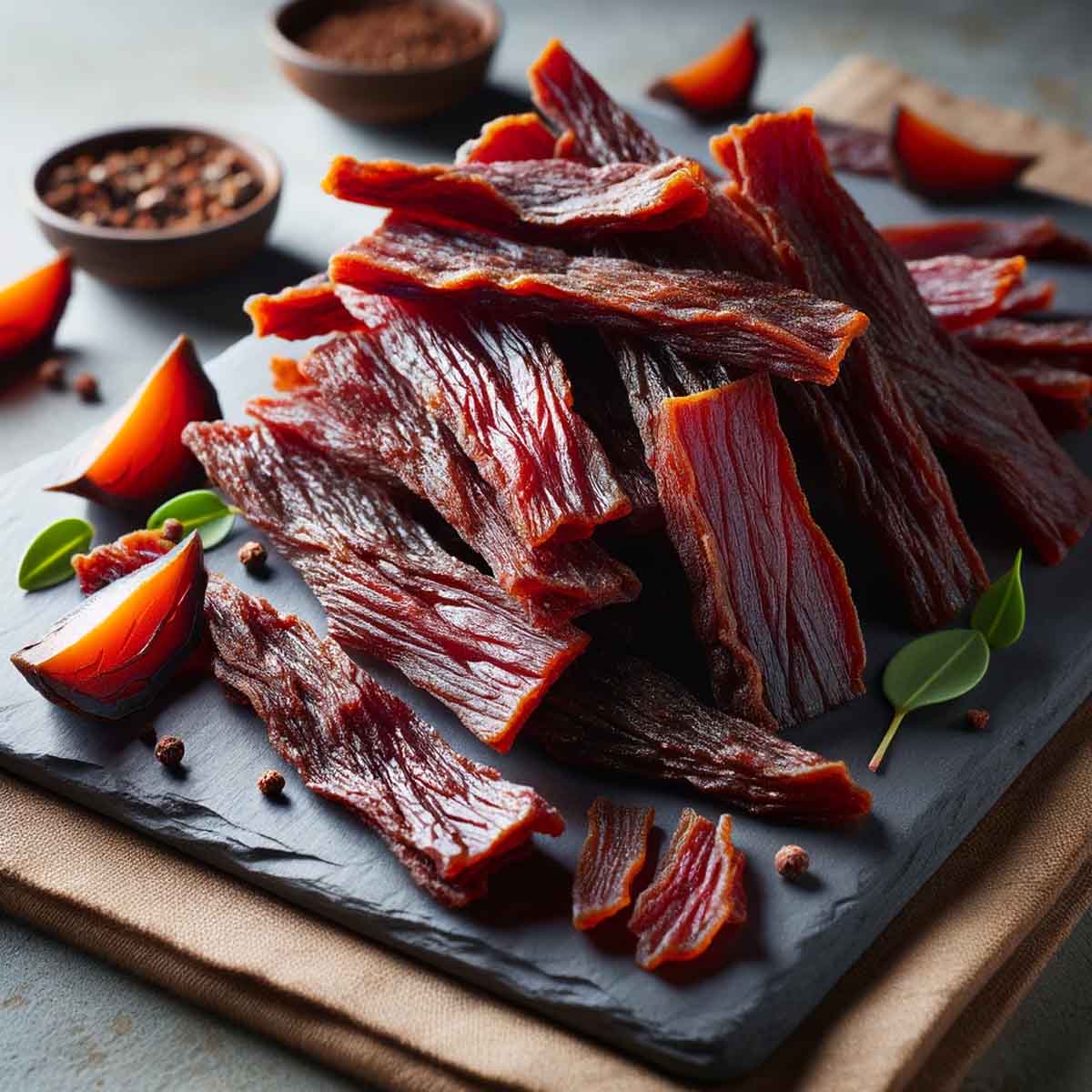There’s an art to creating the perfect batch of beef jerky, and it starts long before the meat hits the dehydrator. I’ll share with you the wisdom of marination—a step that infuses flavor and tenderness into your jerky. In this jerky recipe you’ll unlock the secrets to marinating beef jerky, ensuring each strip is as tantalizing as the last.
Table of Contents
How Long Should You Marinate Your Beef Jerky?
Quick Answer: How Long to Marinate Beef Jerky?
If you’re like me and prefer to cut to the chase, here’s the lowdown: for a robust taste, marinate your beef strips for a minimum of 4-6 hours. However, for those flavors to truly marry and settle down comfortably within the beef, aim for 24 hours in the fridge. Trust me, patience here is a virtue that pays off in delectable dividends.
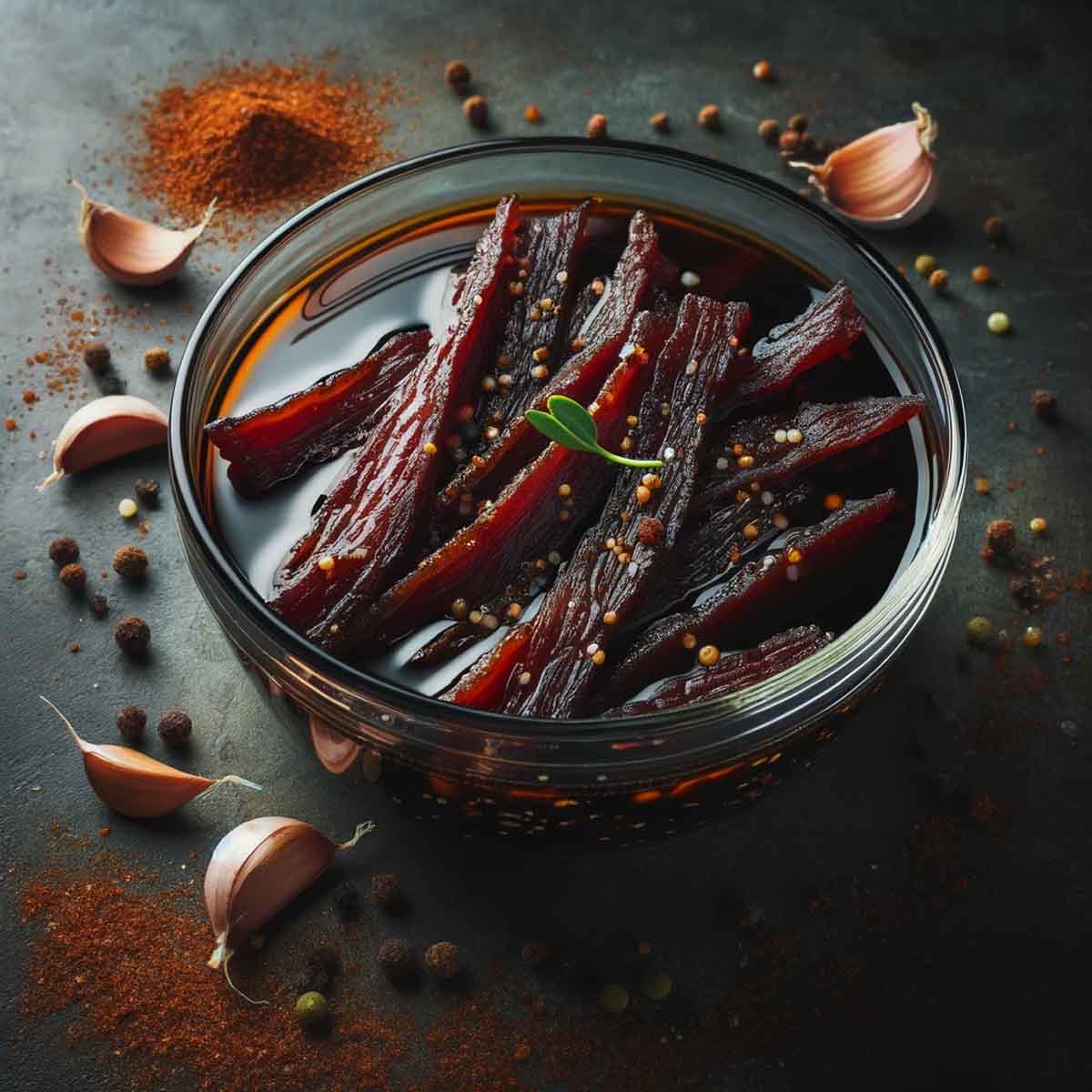
Factors Affecting Marination Time
Not so fast though, there are a few aspects that will swing that marination pendulum one way or another. Let’s break ’em down:
- Thickness of beef slices: Thinner slices are quicker to catch on to those hearty spices than their thicker counterparts.
- Type of marinade: Some marinades like to take their time, especially those with subtle flavors. Bold and spicy ones? They’re quick on the draw.
- Desired flavor intensity: More time in the marinade equals a more intense flavor profile.
Marination Time Based on Thickness
| Thickness of Beef Slices | Recommended Marination Time |
|---|---|
| Thin (1/8” – 1/4”) | 6-12 hours |
| Medium (1/4” – 1/2”) | 12-24 hours |
| Thick (1/2” and above) | 24-48 hours |
Understanding the Marination Process for Beef Jerky
What Is Beef Jerky Marination and Why Does It Matter?
Marination, my fellow jerky enthusiasts, is the process where magic happens. It’s the elaborate dance of flavors where beef is soaked in a concoction of ingredients, which could include the likes of Worcestershire sauce, soy sauce, and various spices. This step is crucial as it directly influences the taste, tenderness, and overall quality of your final product.
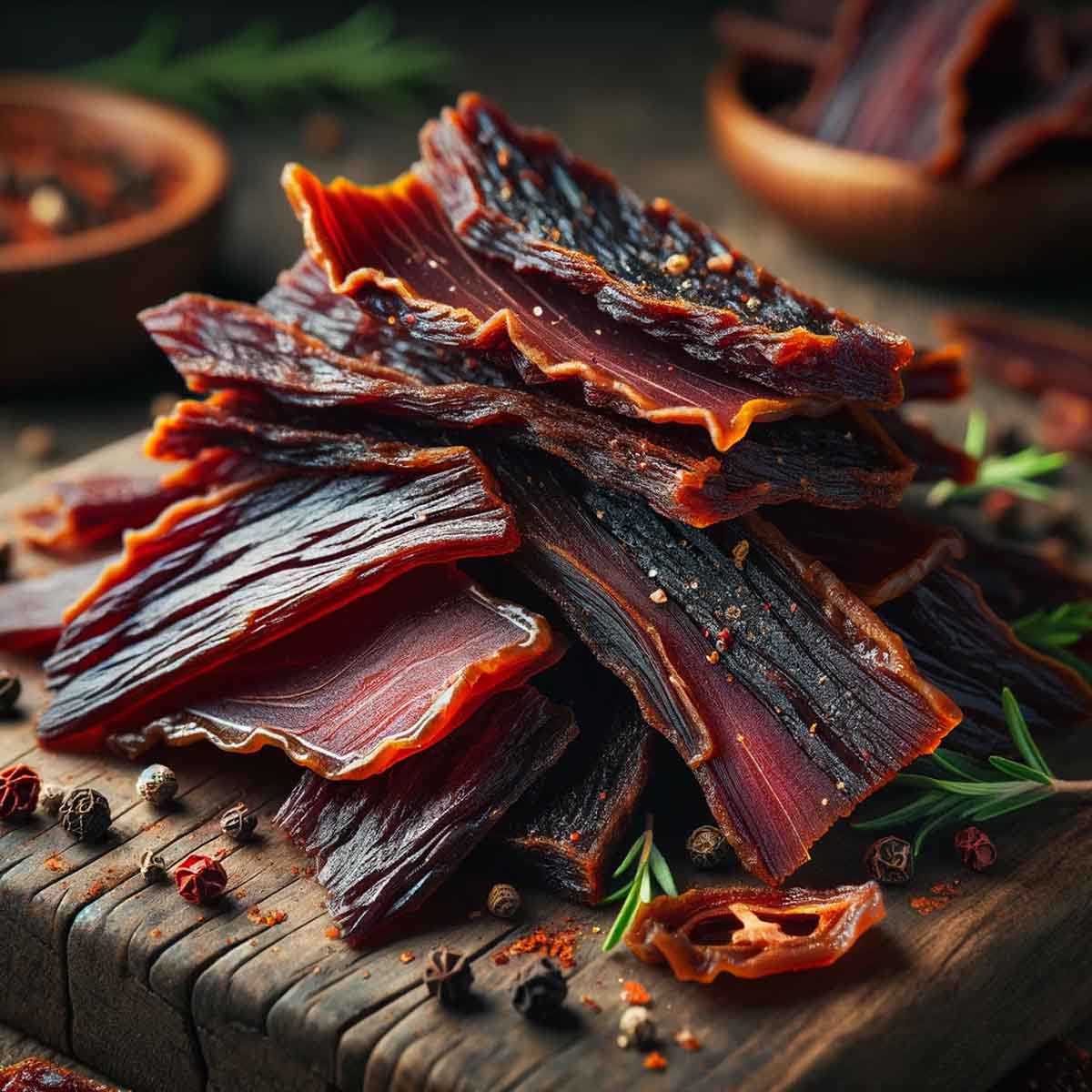
The Role of Marination in Tenderizing and Flavoring Jerky
Here’s the deal, the longer the beef bathes in the marinade, the more pronounced the flavors will become. Not just that, but the acidic components in the marinade—such as vinegar, lemon juice, or even a splash of wine—act as tenderizers, breaking down tough fibers in the meat, ensuring each chew is succulently soft.
Choosing the Right Cut of Beef for Jerky
Making beef jerky is like casting for a movie; picking the right star is half the battle. Your best bets are lean cuts such as top round, London broil, or an eye of round roast. Why? Fat is jerky’s enemy, potentially leading to spoilage and off-flavors. Just remember to trim any excess fat to get the best results.
List of Best Beef Cuts for Jerky:
- Top Round
- London Broil
- Flank Steak
- Eye of Round Roast
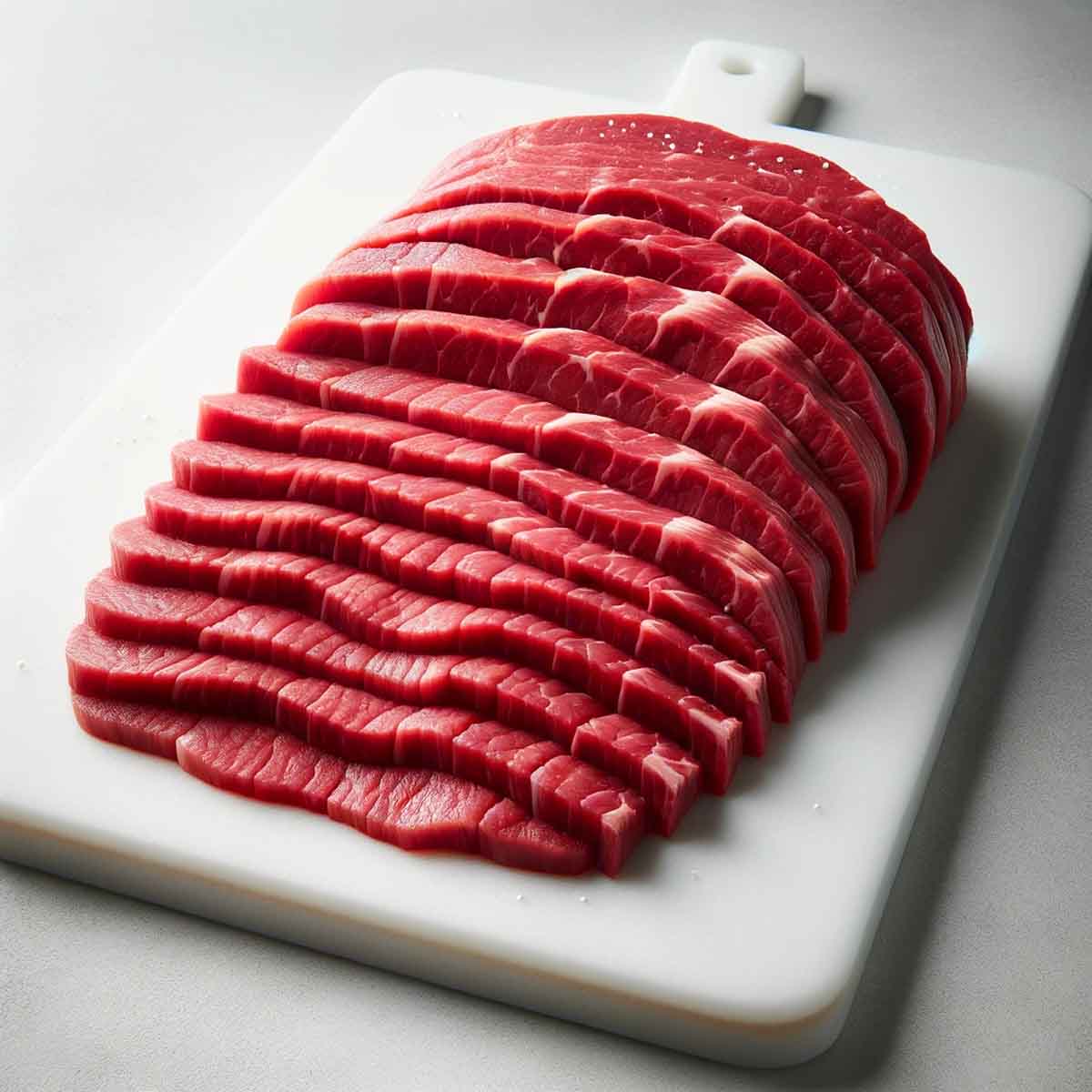
Crafting the Perfect Jerky Marinade
Key Ingredients for a Flavorful Jerky Marinade
To make homemade beef jerky that rivals even the best jerky makers, you need an arsenal of taste guaranteed to blast flavor into every fiber. This means Worcestershire sauce for a savory base, brown sugar for sweetness, and a mixture of garlic and onion powders for a solid flavor foundation. Don’t forget the black pepper for a bit of heat, and perhaps liquid smoke for that hint of campfire.

How to Mix Your Own Beef Jerky Marinade
It’s as easy as pie. Combine your marinade ingredients in a mixing bowl or shake them up in a sealed container. A good balance of sweet, salty, and umami will separate your homemade jerky from the pedestrian packs found at gas stations. Remember to pour this mixture over your beef strips lying flat in an airtight container, or a ziplock bag, ensuring those strips are fully submerged.

The Role of Acidic Ingredients and Sweeteners in Marinades
Essentially, acidic ingredients soften the meat, making it tender. Consider using vinegar variants or even lemon juice. Then there’s the sweet side; brown sugar or maple syrup don’t just balance the flavors, they also contribute to the jerky’s color and glaze. It’s this interplay of acid and sweet that makes a marinade more than just a pool of liquid—it becomes a flavor elevator.
Now that we’ve talked the talk about marinades, let’s walk the walk and cover some beef jerky marination tips straight from the pro’s kitchen.
Expert Tips on Marinating Beef Jerky
Marinating Beef Jerky at Room Temperature vs. Refrigerated
I know you might be tempted to leave that marinating beef out on the counter to speed things up. But hold your horses! Always marinate in the refrigerator. Why? Because safety always comes first. Marinating at room temperature can invite unwanted bacteria to the party, and nobody wants that. The chilled environment of your fridge keeps things safe and sound.
To Seal or Not to Seal: Using Airtight Containers and Plastic Bags
Here’s something I swear by — sealing your beef strips in an airtight container or ziplock bag with as much air squeezed out as possible. This guarantees that every inch of jerky-to-be gets an even handshake with the marinade’s flavors. Plus, it makes it easy to flip and move the pieces around, which brings me to my next point.
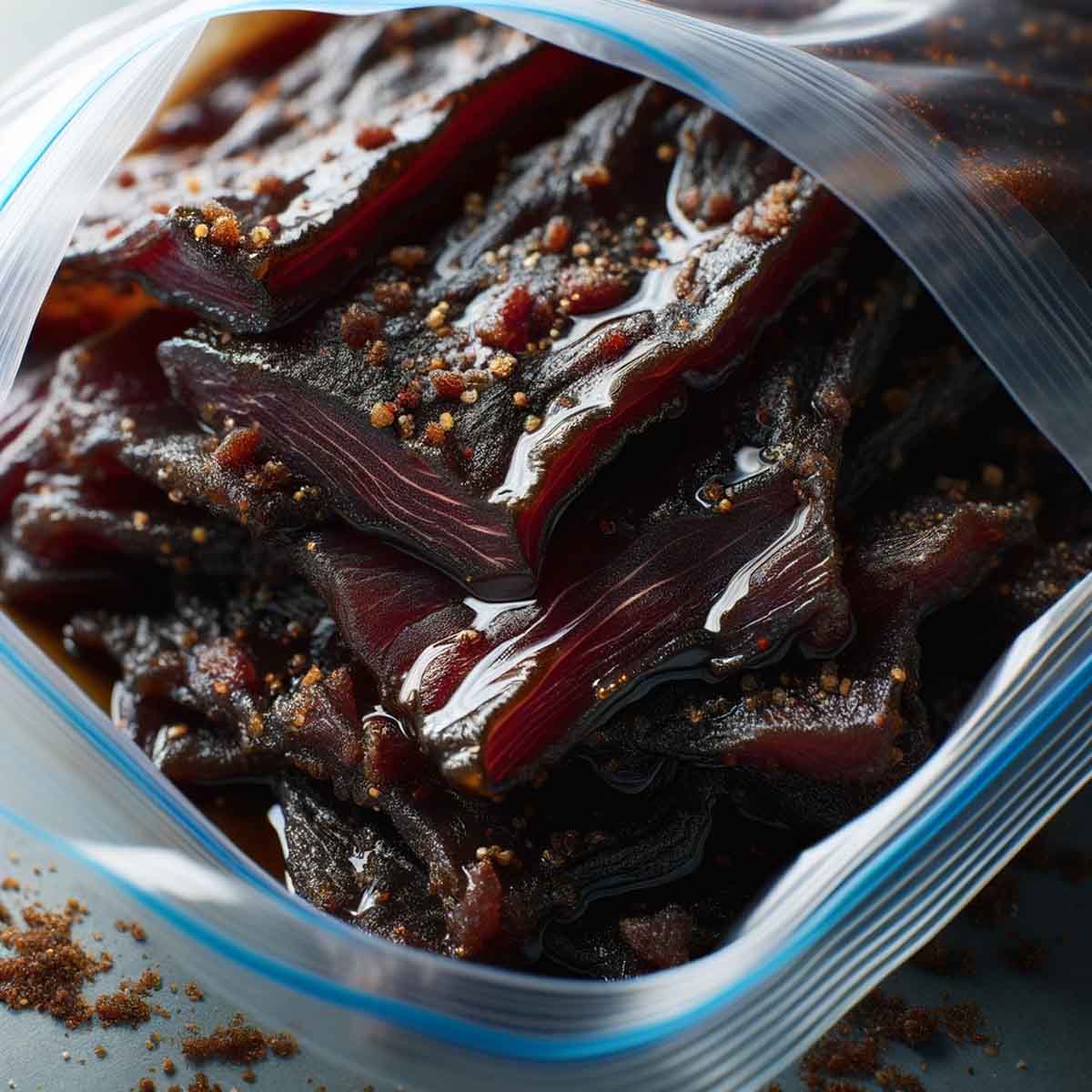
Turning Meat During Marinade: How Often and Why?
Let’s not be lazy; give those bags or containers a gentle flip every few hours. Why? It ensures each piece gets equally cozy with all the flavorful goodness of your marinade. This little dance ensures that no strip feels left out.
Jerky Making Pro-Tip: Testing for the Sweet Spot of Flavor Absorption
Here’s a pro-tip: every so often, take a little taste of the marinade (not the raw meat!). It’s one way to gauge how your homemade jerky will turn out. Think of it as peeking at your presents before Christmas; it only heightens the anticipation.
Believe it or not, we’re halfway to jerky heaven. The next steps are crucial; they’re where good jerky can turn great. Let’s roll up our sleeves and get your beef ready for marination.
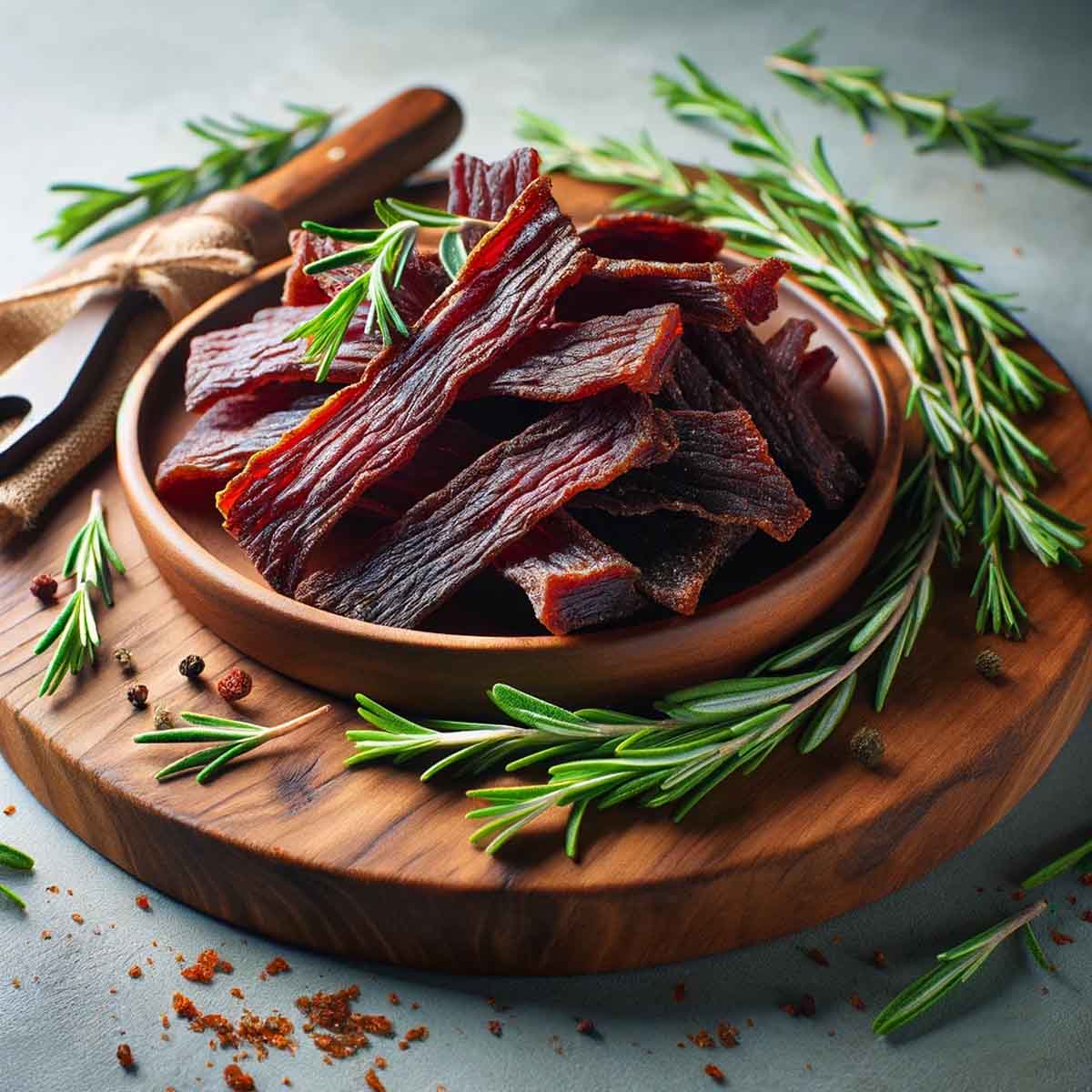
Preparing Beef Jerky for Marination
How to Slice Beef for Jerky: Achieving the Perfect Thinness
Slicing your beef just right is non-negotiable. You’re aiming for even thickness, ideally between 1/8” and 1/4”. Here’s a little secret: semi-freeze the meat to make slicing a breeze. Use a sharp knife or a meat slicer if you’ve got one. Consistent thickness means consistent flavor and drying times, which leads to the best jerky.
List of Slicing Tips:
- Semi-freeze your beef for easier slicing.
- Use a sharp knife or meat slicer.
- Aim for an even thickness of 1/8″ to 1/4″.
Layering Your Beef Strips: Setting Up for Uniform Marinating
Remember to lay those strips in a single layer when marinating. We’re not making a layered cake; we want every piece to have its personal space in marinade paradise. No overlapping, please.
And just like that, we’re ready for what comes after the beef jerky’s spa treatment. It’s time for the post-marinade hustle, where things start heating up. Stay with me; you’re almost there.
After the Marinade: Next Steps in Beef Jerky Preparation
Drying Off Beef Strips Post-Marination
Once your beef has soaked up all that marinated greatness, it’s time to pat them dry. Gently lay the strips on some paper towels and press another layer on top. This isn’t just about tidiness—it’s about prepping the surface for an even dry. Skipping this step could leave you with soggy, unevenly dried jerky, and nobody wants that.
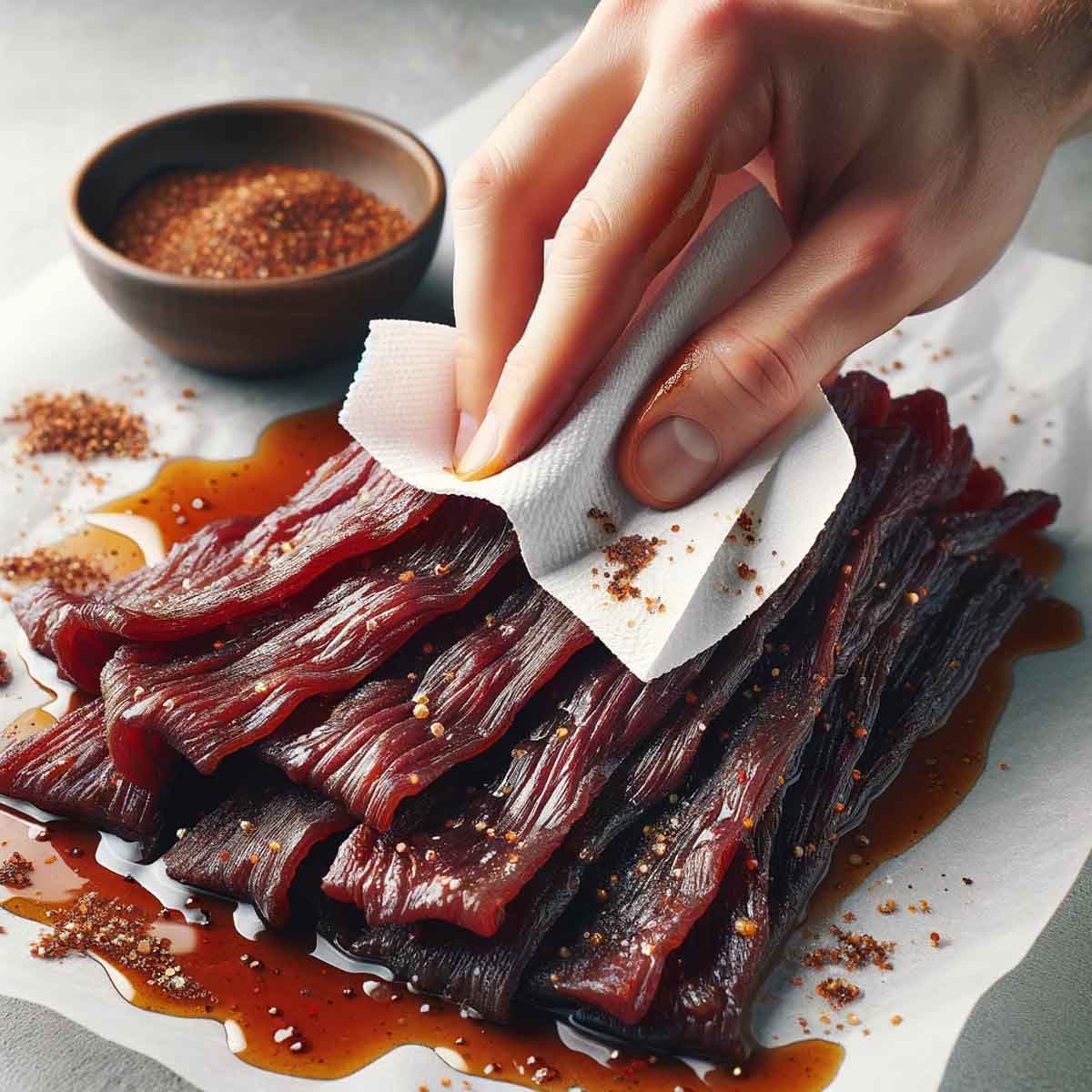
Arranging Beef Strips on Dehydrator Trays or Cooking Racks
Now, we’re not just throwing these marinated treasures onto trays. Arrange them in a single layer on your dehydrator trays or a wire rack over a baking sheet if you’re using an oven. Make sure no pieces are touching or overlapping. Airflow is king in the world of dehydrating; it’s what turns good intentions into great jerky.
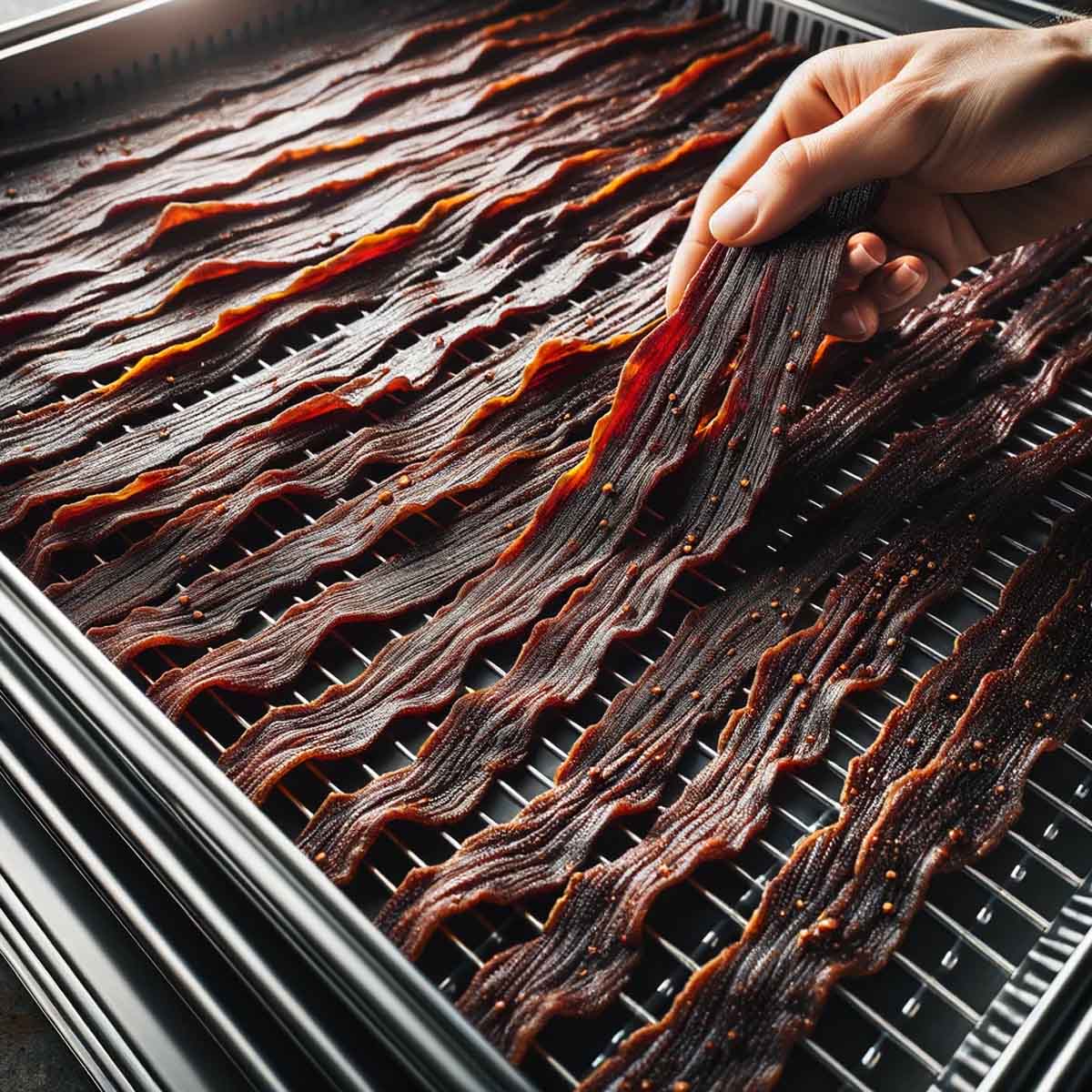
Temperature and Drying Time: Ensuring a Safe and Tasty Outcome
Here’s where things get hot. Literally. Dry your beef at a low heat setting, ideally around 160°F, which, according to the United States Department of Agriculture, is the sweet spot for safely drying meat and ensuring all bacteria are eliminated. The actual drying time can vary, but here’s when patience really becomes your best pal. It can take anywhere from 3 to 8 hours, depending on the thickness of your strips and your drying method.
List of Drying Tips:
- Dry at 160°F (70°C) for safety and quality.
- Expect drying times from 3-8 hours, depending on slice thickness and drying method.
- According to USDA, the drying can sometimes take up to 24 hours.
- Keep an eye on the process to avoid over-drying.
With those strips all lined up and drying, let’s focus on what comes after – storing your well-earned beef jerky.
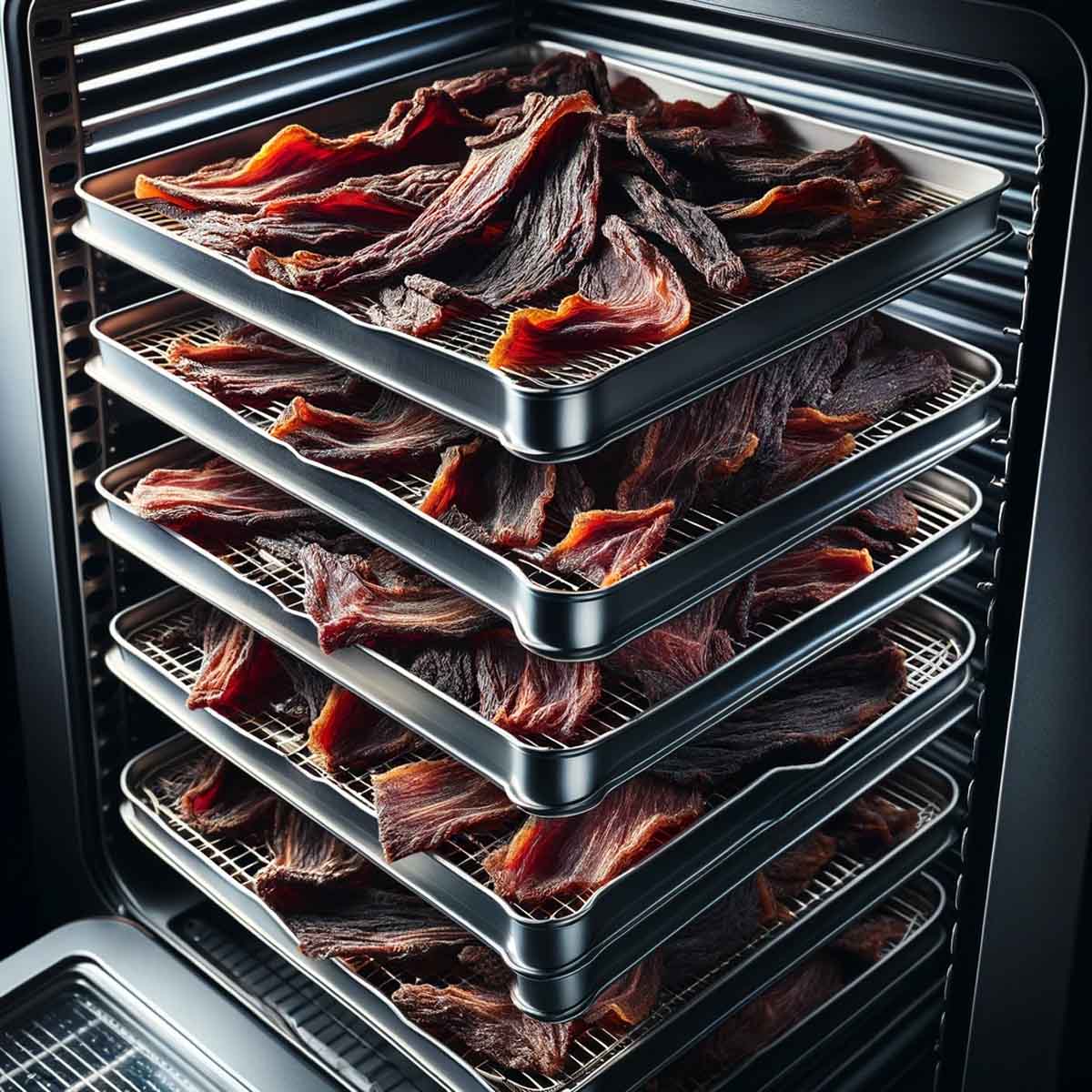
Storing Beef Jerky Post-Marination and Drying
Shelf Life of Homemade Beef Jerky: What to Expect
Alright, I know you’ll want to devour all that jerky the minute it’s ready, but on the off chance you have some self-control, let’s talk storage. Homemade beef jerky can last about 1-2 months in an airtight container at room temperature. If stored in the refrigerator, you can extend that time further.
Best Practices for Extending Your Jerky’s Freshness
To keep your jerky as fresh as the day it came out of the dehydrator, store it in a cool, dry place away from direct sunlight. And remember, the less air, the better. Vacuum sealing is king for long-term storage. Check out my guide on How to Store Beef Jerky for Maximum Shelf Life for all the pro tips.
And there you have it. A little marination, a little slicing, a little drying, and you’ve got yourself a stash of homemade beef jerky. Now let’s answer some of the burning questions jerky lovers might have when they start this journey.

Ultimate Homemade Beef Jerky
Equipment
- sharp knife or meat slicer
- Dehydrator or oven
- mixing bowl
- Ziplock bag or airtight container
- paper towels
Ingredients
Beef:
- 2 lbs lean beef top round or London broil
Marinade:
- 1/2 cup soy sauce low-sodium for dietary consideration
- 1/4 cup Worcestershire sauce
- 2 tablespoons brown sugar
- 1 tablespoon apple cider vinegar
- 1 tablespoon lemon juice
- 2 teaspoons garlic powder
- 2 teaspoons onion powder
- 1 teaspoon freshly ground black pepper
- 1/2 teaspoon liquid smoke optional
Instructions
Preparation:
- Partially freeze beef for easier slicing.
- Slice beef into even strips, approximately 1/8″ to 1/4″ thick.
Making the Marinade:
- Combine soy sauce, Worcestershire sauce, brown sugar, apple cider vinegar, lemon juice, garlic powder, onion powder, black pepper, and liquid smoke in a mixing bowl.
Marinating the Beef:
- Place beef strips in a ziplock bag or airtight container.
- Pour marinade over beef, ensuring all pieces are submerged.
- Marinate in the refrigerator for 24 hours, turning every 6 hours.
Drying the Beef:
- Remove beef from marinade and pat dry with paper towels.
- Arrange beef strips in a single layer on dehydrator trays or a wire rack over a baking sheet.
- Dehydrate at 160 °F for about 6 hours or until desired dryness is achieved.
Storing:
- Allow jerky to cool completely before storing in an airtight container.
Video
Notes
- Meat Selection: Choose lean cuts like top round or London broil. Trim any excess fat to prevent spoilage.
- Marination: For dietary needs, opt for low-sodium soy sauce. Adjust the marination time based on beef thickness.
- Safety: Always marinate in the refrigerator to prevent bacterial growth.
- Acidic Ingredients: Vinegar and lemon juice not only add flavor but also help tenderize the meat.
- Slicing: Partially freezing the beef makes it easier to slice evenly.
- Drying: Ensure no overlapping of beef strips for even drying. Keep an eye on the drying process to avoid over-drying.
- Storage: Store jerky in a cool, dry place. For longer shelf life, vacuum seal.
- Customization: Feel free to experiment with different spices or sweeteners like maple syrup for a unique flavor profile.
- Allergen Information: This recipe contains soy and Worcestershire sauce, which may not be suitable for all diets.

